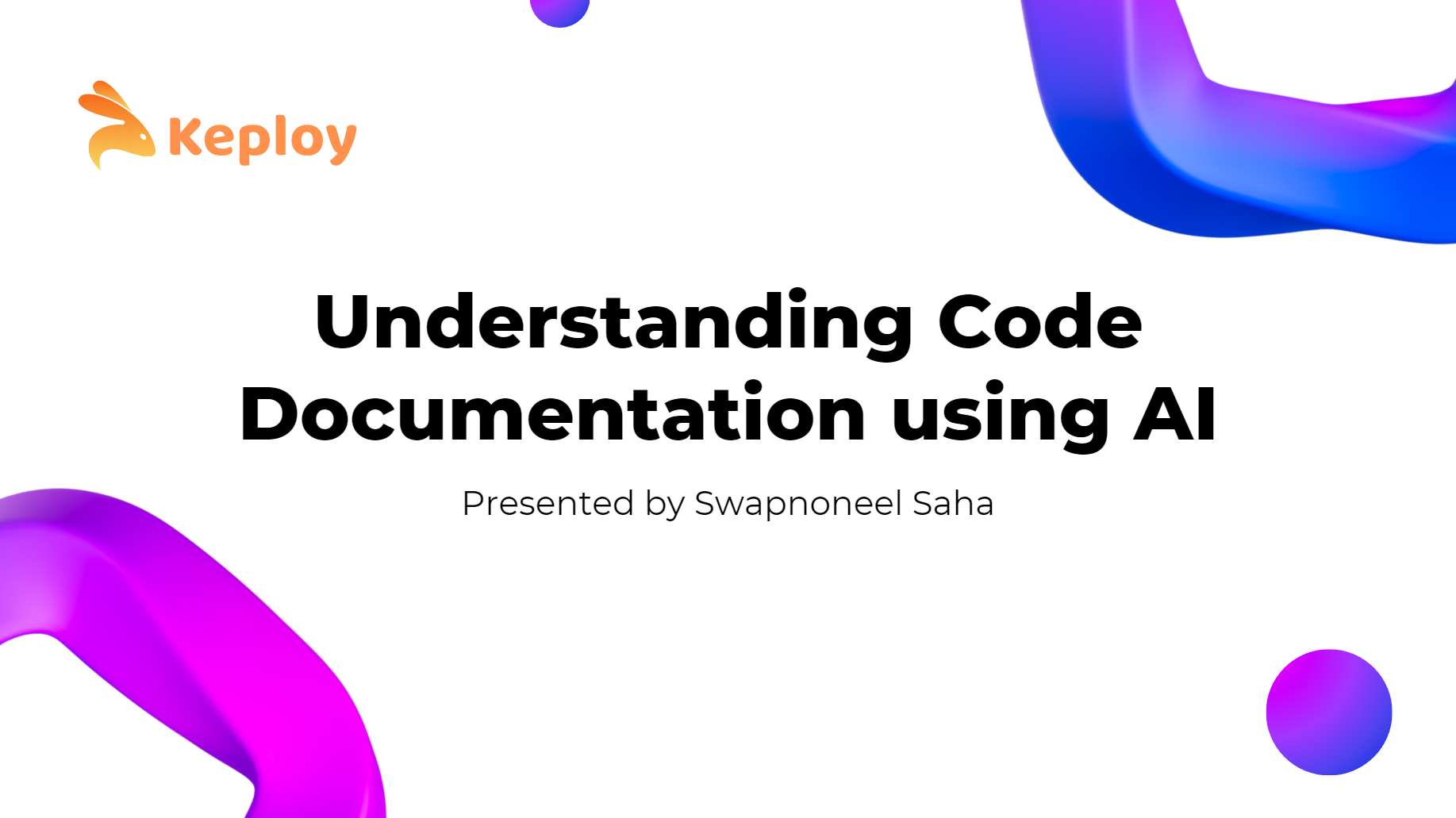The Impact of AI on Code Commenting and Software Documentation
 Swapnoneel Saha
Swapnoneel SahaTable of contents
- Why is Code Documentation and Commenting Important?
- How AI-Powered Tools are Transforming Code Documentation?
- When to Leverage AI for Effective Code Comments
- What is the Future of AI in Code Documentation?
- Can AI be Used to Automate Software Testing?
- Conclusion
- FAQ’s
- Can AI-generated documentation fully replace human effort?
- Does using AI for documentation affect project security?
- Are AI documentation tools customizable for specific project needs?
- Can AI-generated documentation be used as a learning tool?
- How can Keploy help enhance automation in software development?

In modern software development, clear code documentation and commenting are not only just a part of good practices, but also they are essential for effective collaboration, maintainability, and scaling projects over time. However, they are often neglected due to time constraints or lack of clarity on how much detail is necessary.
But, with the advent of artificial intelligence, developers now have tools to streamline this process, allowing them to focus on coding without compromising on clarity. In this blog, we’ll discuss how AI is revolutionizing the world of code documentation and commenting. So, let’s get started!
Why is Code Documentation and Commenting Important?
Before diving into how AI-powered code commenting assists in documentation, it's essential to understand why documenting and commenting code is crucial:
Clarity and Communication: Comments explain the “why” behind code, helping teammates (and your future self) understand the reasoning behind specific approaches.
Debugging and Maintenance: AI in code documentation aids in quickly identifying issues and updating systems without breaking other functionalities.
Onboarding New Team Members: New developers can ramp up faster with concise, NLP-generated code comments that outline the purpose, behavior, and structure of different code segments.Yet, the process is often viewed as a chore. That's where AI comes in.
How AI-Powered Tools are Transforming Code Documentation?
AI-driven code commenting tools, leveraging NLP in code documentation, are changing how developers handle commenting. Here’s how:
Automated Comment Generation: Tools like GitHub Copilot and Amazon CodeWhisperer analyze your code and automatically generate descriptive comments. For instance, when writing a function that calculates the factorial of a number, the AI-powered code comments might suggest:
Example: Writing a function that calculates the factorial of a number might automatically generate comments like:
# This function calculates the factorial of a given integer. # It uses recursion to find the product of all positive integers up to n. def factorial(n): if n <= 1: return 1 return n * factorial(n - 1)Code Summarization: Advanced AI for developers can generate summaries of entire code files, providing a high-level overview without diving into each line—a significant advantage for lengthy codebases.
Integration with Development Environments: Many automated coding assistance tools integrate seamlessly with IDEs like VS Code, enabling developers to receive real-time suggestions while coding.
Standardization and Consistency: AI can enforce consistency in documentation style, terminology, and formatting across a project, helping to uphold best practices and support smoother collaboration.
When to Leverage AI for Effective Code Comments
While AI-driven documentation tools are powerful, understanding when and where to add comments remains essential. Here are some best practices for using AI in code documentation effectively:
Avoid Over-Commenting: Only add comments to complex logic, critical code segments, or areas where clarity is necessary.
Prioritize Value: Comments should provide additional context without restating obvious logic.
Regularly Review Comments: AI-generated comments may become outdated over time. Make it a habit to review and update comments to keep documentation accurate.
What are the Challenges of Using AI in Code Documentation?
Although AI is a valuable tool, it is not without challenges and also comes it’s own limitations and flaws:
Potential for Inaccurate Documentation: AI-generated comments may sometimes misinterpret the intention of complex code, leading to inaccuracies. That’s why, we need to re-check the generated comments to ensure that they are correct.
Dependency Concerns: If you are relying too heavily on AI without cross-checking, it could lead to a lack of critical thinking or misunderstandings in your codebase.
Bias and Security Risks: Kee[ in mind, AI models are trained on publicly available code that may inadvertently introduce security risks or biases. That’s why, you have to always ensure that the generated documentation aligns with organizational standards and security policies.
What is the Future of AI in Code Documentation?
The role of AI in code documentation is evolving rapidly and the future advancements could bring even more intelligent systems capable of understanding broader software contexts, which can also integrate with task management tools, and even learning the coding styles of individual developers or teams. By reducing the manual burden of commenting and documentation, AI empowers developers to focus on building innovative, high-quality software while ensuring their code remains transparent and accessible.
Can AI be Used to Automate Software Testing?
Just as AI tools for developers can enhance documentation, they can also streamline testing. Keploy, for instance, offers automated testing solutions that generate test cases and mocks for unit, integration as well as e2e testing. It’s straightforward to use and integrates seamlessly with IDEs like VS Code, allowing you to improve testing efficiency while maintaining code quality.
So, wouldn’t it be great if there was a AI tool that can automate this task too? Yes, that’s where Keploy comes in. Keploy is an AI based test case and stubs/mocks generator for integration and unit testing. And also, it’s extremely easy-to-use and is also available directly through your IDEs, like VS Code! So go ahead and give it a try now!
Conclusion
AI has transformed both code documentation and automated software testing, enabling developers to maintain clarity and consistency without slowing down. Embracing AI-driven code commenting and testing tools like Keploy means better collaboration, maintainable software, and a brighter, more productive future for developers.
For more information, follow me on Twitter (swapnoneel123) where I share more such content through my tweets and threads. And, please consider sharing it with others on Twitter and tag me in your post so I can see it too. You can also check my GitHub (Swpn0neel) to see my projects.
I wish you a great day ahead and till then keep learning and keep exploring!!

FAQ’s
Can AI-generated documentation fully replace human effort?
No, AI-generated documentation should complement, not replace, human effort. While AI tools provide a great starting point, developers are needed to review, refine, and ensure that comments accurately reflect the code’s purpose. Human oversight ensures clarity, avoids inaccuracies, and accounts for context and project-specific nuances that AI might miss.
Does using AI for documentation affect project security?
Potentially, yes. AI tools may inadvertently generate comments that expose sensitive logic or highlight potential weaknesses in the code. It’s essential to review all AI-generated comments for security implications and ensure they align with the project’s security protocols.
Are AI documentation tools customizable for specific project needs?
Yes, many AI-powered documentation tools offer some degree of customization. Developers can configure rules for comment styles, preferred templates, or even teach the model about specific code structures common to the project or organization. This ensures more accurate, tailored output.
Can AI-generated documentation be used as a learning tool?
Absolutely! For newer developers or team members, AI-generated documentation can serve as a useful starting point to understand unfamiliar codebases. It can provide immediate context and overviews, aiding faster comprehension. Paired with tools like Keploy for testing, new members can experiment and learn how different parts of the system interact.
How can Keploy help enhance automation in software development?
Keploy, known for its focus on test generation and automation, can be a complementary tool when used with AI-driven documentation tools. By generating test cases automatically, it ensures that critical functionalities are validated.
Subscribe to my newsletter
Read articles from Swapnoneel Saha directly inside your inbox. Subscribe to the newsletter, and don't miss out.
Written by

Swapnoneel Saha
Swapnoneel Saha
Hello, I'm Swapnoneel Saha and I am currently in my sophomore year. I am a Front-End Developer, Programmer and an open-source enthusiast. I am passionate about exploring new technologies and contributing to open-source projects. In my free time, I enjoy learning about new programming languages and staying up-to-date with the latest developments in the tech industry. Follow my blog to stay informed about my latest articles and projects.

